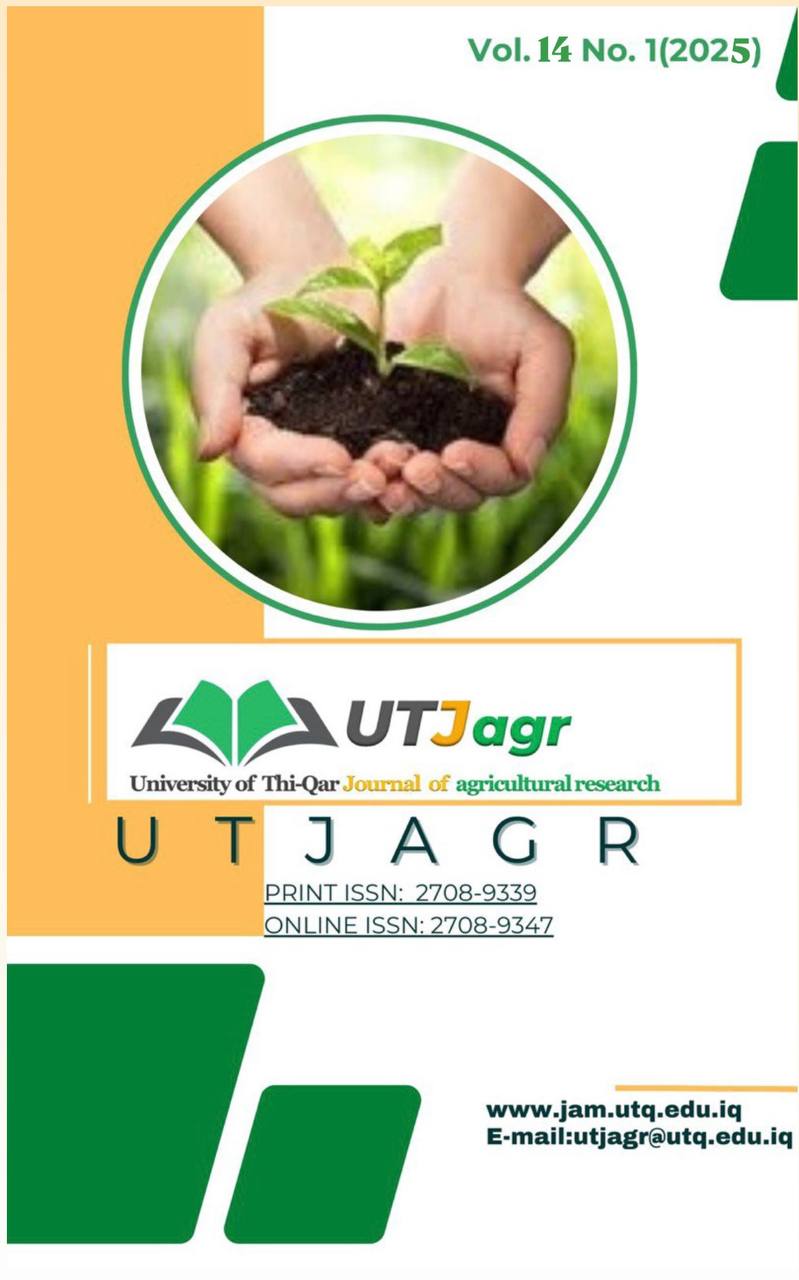The Effect of Growth Hormone in Increasing Flowering of Gardenia Jasminoides L.
DOI:
https://doi.org/10.54174/7b0g5m11Keywords:
Gardenia, Growth Hormone, Flowering, Propagation, Rooting, Auxin, Abscisic acid.Abstract
Gardenia plants are characterized by the beauty of leaves and aromatic flowers, that makes them one of the most important types of ornamental plants. Traditional propagation methods such as seeds and cuttings are considered insufficient to achieve high propagation rates, for this reason, plant tissue culture techniques were used. This study was conducted in Plant Tissue Culture Laboratory of College of Agriculture at University of Kufa, during period from September 5, 2024 to March 5, 2025. Plant parts were used, represented by (shoot tips) and (nodal segments), from the shady (dwarf) variety Cardinia known as (Radicans). The effect of Benzyl Adenine (BA) concentrations on emergence of seedlings appeared from planting shoot tips of Cardinia plant after (4) weeks of cultivation. The 1 mg/L treatment was most effective, that recording highest shoot length (11.0 cm) and number of shoots (1.9), while 0 mg/L treatment achieved highest number of leaves (3.1), but had lower branch length (0.40 cm). The 0.5 mg/L treatment also showed good response, achieving high leaf width (2.1 cm) despite decrease in number of shoots to 1.2. In contrast, the 1.5 mg/L treatment showed an increase in number of branches (2.0) and number of leaves (3.9), but recorded lower shoot length (0.60 cm). On the other hand, 2 mg/L treatment was the least effective, recording lowest number of leaves (0.04) and shoot length (0.10 cm). While the effect of different concentrations of (BA) on multiplying gardenia plants was shown after 12 weeks of cultivation, and concentration 1.5 mg/L recorded highest number of shoots (4.5) and highest number of leaves (4.55), which indicating the effectiveness of this concentration in promoting growth, while concentration of 2.5 mg/L was lowest, recording lowest number of shoots (0.55) and lowest number of leaves (1.85). As for effect of Naphthalene Acetic Acid (NAA) concentrations on emergence of plantlets from tips of gardenia plant after (4) weeks of cultivation, highest response was shown at concentration of 2.5 mg/L, where a 100% response rate was recorded with shoot lengths of (10.3) cm and number of leaves of (39). While the concentration of 0 mg/L was lowest, as no response or growth was recorded. While effect of (NAA) concentrations on growth of gardenia plant was shown after (12) weeks of planting, plants at concentration of 0 mg/L did not show any response, as all values were zero. With increasing concentration to 0.5 mg/L, a complete response (100%) was shown, with production of 5.12 shoots and branch length of (1.65) cm. At concentration of 1 mg/L, the number of shoots decreased to (4.50), Although the response remained complete.
Downloads
References
Ibrahim, Faisal Hussein Ibrahim (2005). In vitro rooting of apple rootstocks and acclimatization of productive plants. Master's thesis, MM106 Technical College/Al-Musayyab, Iraq.
Hamid, Mohammed Khazal (1994). Vegetative propagation of pistachio trees using plant tissue culture (Pistacia vera L.). Master's thesis, College of Agriculture, University of Baghdad, Iraq.
Al-Khafaji, Maki Alwan (2014). Plant growth regulators: their applications and horticultural uses. University House for Printing, Publishing, and Translation, Ministry of Higher Education and Scientific Research, College of Agriculture, University of Baghdad, Iraq.
Al-Rawi, Khasha' Mahmoud, and Abdul Aziz Mohammed Khalaf Allah (1980). Design and Analysis of Agricultural Experiments. Ministry of Higher Education and Scientific Research, Dar Al-Kutub for Printing and Publishing, University of Mosul, Iraq, 488 pages.
He S-Y, Qian Z-Y, Tang F-T, Wen N, Xu G-L, Sheng L. Effect of crocin on experimental atherosclerosis in quails and its mechanisms. Life Sciences. 2005;77(8):907–921. doi: 10.1016/j.lfs.2005.02.006. [DOI] [PubMed] [Google Scholar]
Tseng T-H, Chu C-Y, Huang J-M, Shiow S-J, Wang C-J. Crocetin protects against oxidative damage in rat primary hepatocytes. Cancer Letters. 1995;97(1):61–67. doi: 10.1016/0304-3835(95)03964-x. [DOI] [PubMed] [Google Scholar]
Hatzilazarou SP, Syros TD, Yupsanis TA, Bosabalidis AM, Economou AS. Peroxidases, lignin and anatomy during in vitro and ex vitro rooting of gardenia (Gardenia jasminoides Ellis) microshoots. Journal of Plant Physiology. 2006;163(8):827–836. doi: 10.1016/j.jplph.2005.06.018. [DOI] [PubMed] [Google Scholar]
Pontikis CA. In vitro propagation of Gardenia jasminoides . Plant Propagator. 1983;29:13–14. [Google Scholar]
Al-Juboory KH, Skirvin RM, Williams DJ. Callus induction and adventitious shoot regeneration of gardenia (Gardenia jasminoides Ellis) leaf explants. Scientia Horticulturae. 1998;72(3-4):171–178. [Google Scholar]
Chen Y, Zhang H, Li Y-X, et al. Crocin and geniposide profiles and radical scavenging activity of gardenia fruits (Gardenia jasminoides Ellis) from different cultivars and at the various stages of maturation. Fitoterapia. 2010;81(4):269–273. doi: 10.1016/j.fitote.2009.09.011. [DOI] [PubMed] [Google Scholar]
Sayd SS, Taie HAA, Taha LS. Micropropagation, antioxidant activity, total phenolics and flavonoids content of Gardenia jasminoides Ellis as affected by growth regulators. International Journal Academic Research. 2010;2:184–191. [Google Scholar]
Debnath T, Park P-J, Deb Nath NC, Samad NB, Park HW, Lim BO. Antioxidant activity of Gardenia jasminoides Ellis fruit extracts. Food Chemistry. 2011;128(3):697–703. [Google Scholar]
Izzo AA, Di Carlo G, Biscardi D, et al. Biological screening of italian medicinal plants for antibacterial activity. Phytotherapy Research. 1995;9(4):281–286. [Google Scholar]
Murashige T, Skoog F. A revised medium for rapid growth and bioassays with tobacco cultures. Physiologia Plantarum. 1962;15:473–497. [Google Scholar]
Lloyd G, Mc Cown B. Commercially feasible micropropagation of mountain laurel, Kalmia latifolia, by use of shoot tip culture. Combined Proceedings, International Plant Propagators' Society. 1980;30:421–427. [Google Scholar]
Gupta PK, Durzan DJ. Biotechnology of somatic polyembryogenesis and plantlet regeneration in loblolly pine . Bio/Technology. 1987;5(2):147–151. [Google Scholar]
Khorasani A, Sani W, Philip K, Taha RM, Rafat A. Antioxidant and antibacterial activities of ethanolic extracts of Asparagus officinalis cv. Mary Washington: Comparison of in vivo and in vitro grown plant bioactivities. African Journal of Biotechnology. 2010;9(49):8460–8466. [Google Scholar]
Kil HY, Seong ES, Ghimire BK, et al. Antioxidant and antimicrobial activities of crude sorghum extract. Food Chemistry. 2009;115(4):1234–1239. [Google Scholar]
Eeckhaut T, Janssens K, Keyser ED, Riek JD. Micropropagation of rhododendron. In: Jain SM, Ochatt SJ, editors. Protocols For in Vitro Propagation of Ornamental Plants, Methods in Molecular Biology. Helsinki, Finland: Humana Press; 2010. pp. 141–152. [DOI] [PubMed] [Google Scholar]
Duhoky M, Rasheed K. Effect of different concentrations of kinetin and NAA on micropropagation of Gardenia jasminoides . Journal of Zankoy Sulaimani A. 2010;13:103–120. [Google Scholar]
Abdel-Rahim E, Abdel-Fattah OM, Kabasse MI, El-Shemy H, El-?Samei MB. Growth of date palm callus as affected by growth regulators, sugars as carbon source and amino acids as organic nitrogen source. Arab Journal of Biotechology. 1998;1:99–106. [Google Scholar]
Behbahani M, Shanehsazzadeh M, Hessami MJ. Optimization of callus and cell suspension cultures of Barringtonia racemosa (Lecythidaceae family) for lycopene production. Scientia Agricola. 2011;68(1):69–76. [Google Scholar]
Basri DF, Fan SH. The potential of aqueous and acetone extracts of galls of Quercus infectoria as antibacterial agents. Indian Journal of Pharmacology. 2005;37(1):26–29. [Google Scholar]
Abu-Shanab B, Adwan G, Abu-Safiya D, Adwan K, Abu-Shanab M. Antibacterial ýactivity of Rhus coriaria. L extracts growing in Palestine. Journal of the Islamic University of Gaza. 2005;13:147–153. [Google Scholar]
Wei LS, Musa N, Sengm CT, Wee W, Shazili NAM. Antimicrobial properties of tropical plants against 12 pathogenic bacteria isolated from aquatic organisms. African Journal of Biotechnology. 2008;7(13):2275–2278. [Google Scholar]
Abdul Manaf A. Antimicrobial activity of selected Malaysian plants. Pertanika Journal of Tropical Agricultural Science. 1995;18:57–61. [Google Scholar]
Møretrø T, Sonerud T, Mangelrød E, Langsrud S. Evaluation of the antibacterial effect of a triclosan-containing floor used in the food industry. Journal of Food Protection. 2006;69(3):627–633. doi: 10.4315/0362-028x-69.3.627. [DOI] [PubMed] [Google Scholar]
Ragasa CY, Pimenta LEN, Rideout JA. Iridoids from Gardenia jasminoides . Natural Product Research. 2007;21(12):1078–1084. doi: 10.1080/14786410701589998. [DOI] [PubMed] [Google Scholar]
Wei S, Li Z, Jian-Tao L, Hua L, Xiao-Hua W, Dan L. Antioxidant Activity of Total Saponins from Gardenia jasminoides Fruits. Food Science. 2009;30:75–77. [Google Scholar]
Miszalski Z, Kornas A, Gawronska K, et al. Superoxide dismutase activity in C3 and C3/CAM intermediate species of Clusia . Biologia Plantarum. 2007;51(1):86–92. [Google Scholar]
Dos Santos WG, Pacheco I, Liu M-Y, Teixeira M, Xavier AV, LeGall J. Purification and characterization of an iron superoxide dismutase and a catalase from the sulfate-reducing bacterium Desulfovibrio gigas. Journal of Bacteriology. 2000;182(3):796–804. doi: 10.1128/jb.182.3.796-804.2000. [DOI] [PMC free article] [PubMed] [Google Scholar]
Shilpashree R, Kumar SB. A study on anti-stress property of Nardostachys jatamamsi on stress induced Drosophila melanogaster . Journal of Stress Physiology and Biochemistry. 2011;7:159–164. [Google Scholar]
Fan Y, Ge Z, Luo A. In vitro antioxidant activity of polysaccharide from Gardenia jasminoides Ellis. Journal of Medicinal Plant Research. 2011;5(14):2963–2968. [Google Scholar]
Lee S-J, Oh P-S, Ko J-H, Lim K, Lim K-T. Glycoprotein isolated from Gardenia jasminoides Ellis has a scavenging activity against oxygen radicals and inhibits the oxygen radical-induced protein kinase C alpha and nuclear factor-kappa B in NIH/3T3 cells. Environmental Toxicology and Pharmacology. 2006;21(1):8–21. doi: 10.1016/j.etap.2005.04.003. [DOI] [PubMed] [Google Scholar]
Pham TQ, Cormier F, Farnworth E, Van Tong H, Van Calsteren M-R. Antioxidant properties of crocin from Gardenia jasminoides Ellis and study of the reactions of crocin with linoleic acid and crocin with oxygen. Journal of Agricultural and Food Chemistry. 2000;48(5):1455–1461. doi: 10.1021/jf991263j. [DOI] [PubMed] [Google Scholar]
Mohamed, S. S. ; Hassan, N. M. and Waheed, B. (2005). Recklessness and Ornamental Plants, Al-Basateen Houses Institute, Cairo, Egypt.
Teixeira da Silva, J. A.; Shinoyama, H.; Aida, R.; Matsushita, Y.; Raj, S. K. and Chen, F. (2013). Chrysanthemum biotechnology: Quo vadis?. Critical Reviews in Plant Sciences, 32(1): 21-52.
Bhattacharjee, S. K. (2006). Advances in Ornamental Horticulture, Volume2. Institute of Horticultural Research. Bangalore. Aavishkar Publishers Distributors. Agricultural, New Delhi. India.
Vaghasia, M. and Polara, N.D. (2015). Effect of Plant Growth Retardants onGrowth, Flowering and Yield of Chrysanthemum (Chrysanthemum morifolium Ramat.) cv. IIHR- 6. Malays. J. Med. Biol. Res., 2(2):161-166.
Philippine, H. (2006). Franchising growing Chrysanthemum and Orchids. Netherlands. J. Amer. Soc. Hort. Sci. 108 (1): 118–121. Journal of Kerbala for Agricul
Ahmad, N., Ali, S., & Ali, M. (2019). Effects of Plant Growth Regulators on Growth and Development of Various Plant Species. Journal of Plant Growth Regulation, 38(2), 456-467.
Kumar, R., Singh, A., & Gupta, N. (2018). Influence of Benzyladenine on Growth Parameters of Ornamental Plants. Horticultural Science, 45(3), 212-219.
Zhang, Y., Li, X., & Chen, L. (2020). The Role of Cytokinins in Plant Development and Stress Response. Plant Physiology, 182(4), 1885-1902.
Ahmad, N., Ali, S., & Ali, M. (2019). Effects of Plant Growth Regulators on Growth and Development of Various Plant Species. Journal of Plant Growth Regulation, 38(2), 456-467.
Kumar, R., Singh, A., & Gupta, N. (2018). Influence of Benzyladenine on Growth Parameters of Ornamental Plants. Horticultural Science, 45(3), 212-219.
Zhang, Y., Li, X., & Chen, L. (2020). The Role of Cytokinins in Plant Development and Stress Response. Plant Physiology, 182(4), 1885-1902.
Zhao, C., Wang, H., & Liu, Y. (2021). The Effect of NAA on Growth and Development of Plant Tissue Cultures. Plant Cell Reports, 40(4), 789-799.
Ali, M., Hussain, A., & Khan, M. (2019). Role of Auxins in Plant Growth and Development: A Review. International Journal of Botany, 15(3), 145-156.

Downloads
Published
Issue
Section
License
Copyright (c) 2025 alyaa Hussein

This work is licensed under a Creative Commons Attribution-NonCommercial-ShareAlike 4.0 International License.







1.png)

